
Kenton is a town in Kent County, Delaware, United States. It is part of the Dover metropolitan statistical area. The population was 215 in 2020.

Sugartown is an unincorporated settlement that is located in central Willistown Township, Chester County, Pennsylvania, United States, at the intersection of Sugartown and Boot Roads. It is situated eighteen miles west of Philadelphia.

The Centre Harbor Village Historic District encompasses the historic village of Center Harbor, New Hampshire. It consists of a small cluster of properties located north of Plymouth Street and Main Street, as well as the Nichols Memorial Library, and the Kona Fountain, which is located in the center of that intersection. It was added to the National Register of Historic Places in 1983.
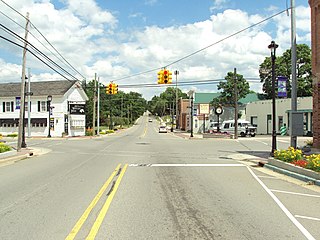
The Metamora Crossroads Historic District is a historic district centered at the intersection of Oak and High Street in the small village of Metamora in Metamora Township in Lapeer County, Michigan. It was designated as a Michigan State Historic Site and also added to the National Register of Historic Places on July 19, 1984.
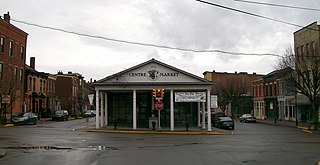
Centre Market Square Historic District is a historic district in Wheeling, West Virginia, listed on the National Register of Historic Places.

Aiken's Tavern Historic District is a historic district in New Castle County, Delaware, comprising the historic center of the village of Glasgow. The district includes the site of Aiken's Tavern, an important landmark at the time of the American Revolutionary War. The district was listed on the National Register of Historic Places in 1977.
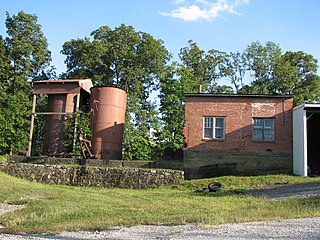
Byers Station Historic District is a national historic district located in Upper Uwchlan Township, Chester County, Pennsylvania, United States. The district includes 26 contributing buildings in the crossroads community of Byers Station. The buildings date to the 19th century and include a number of notable Italianate style buildings. Notable buildings include a variety of residences, a factory, a Masonic lodge (1894), and the former Byers Hotel. The community grew around the Byers railroad station, after its opening in 1871, and continued after plumbago (graphite) was discovered in the area in 1875.
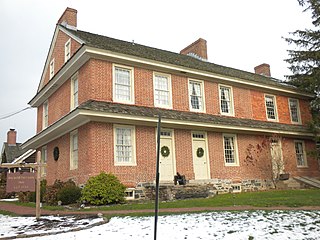
Dilworthtown Historic District is a national historic district located in Dilworthtown, Birmingham Township, Chester County, Pennsylvania. It encompasses eight contributing buildings in the crossroads community of Dilworthtown. They include the Dilworth House, stone house (1820), Dilworthtown Lyceum or meeting hall, Dilworthtown Store (1858), two tenant houses, and a two-story log cabin dated to 1686 or the early-18th century. The focal point of the district is the Dilworth House, also known as the Dilworthtown Inn, which has operated as an inn and tavern since the late 18th century. The town was at the center of the fighting during the Battle of Brandywine in September 1777.
Thomas Lamb Farm, also known as "Brick House Farm", is a historic home located at Kenton, Kent County, Delaware. The house dates to the second quarter of the 18th-century, and is a two-story, three-bay, single pile brick dwelling. It has a hall-and-parlor plan. Attached is a 1+1⁄2-story, three-bay brick kitchen wing with a porch.

Townsend Historic District is a national historic district located at Townsend, New Castle County, Delaware. It encompasses 216 contributing buildings and 5 contributing structures in the crossroads and railroad village of Townsend. It includes a mix of commercial and residential buildings primarily dating to the late-19th century and early-20th century. Notable buildings include the Immanuel M. E. Church and Parsonage, Lattamus store (1851), Dr. Niles house, Maloney Store, Townsend-Dickenson Hotel/Harmon's Drug Store, Evan's Store, Hart's Grain, Seed and Coal Store, S. Townsend house, Winfield Cottage, school (1932), and the former St. Mary's Episcopal Church.

New Market Historic District is a national historic district located at New Market, Shenandoah County, Virginia. The district encompasses 11 contributing buildings in the crossroads town of New Market. It includes a variety of commercial, residential, and institutional buildings dating primarily from 19th century. They are in a variety of popular architectural styles including Victorian, Federal, and Georgian. Notable buildings include the Henkel house, Lee-Jackson Hotel, Solon Henkel House, Salyard House, Rupp House, and Emmanuel Lutheran Church.

The Chesterfield Center Historic District is a historic district that encompasses the traditional village center of the town of Chesterfield, Massachusetts. The village is reflective of the town's 18th and 19th-century development as an agrarian hill community, with architectural styles before about 1850 predominating. The district was listed on the National Register of Historic Places in 2000.

The Head of the River Historic District is a historic district encompassing a village area at the head of navigation of the Acushnet River, which separates Acushnet and New Bedford, Massachusetts. The village is centered at the junction of Tarkiln Hill Road, River Road, and Mill Road in New Bedford, and Main Street in Acushnet. The area went through two significant periods of development: the first was in the late 18th and early 19th century, and the second was in the early 20th century. The district was listed on the National Register of Historic Places in 2009.

The Townsend Farm is a historic farmstead on East Harrisville Road in Dublin, New Hampshire. Built about 1780 and enlarged about 1850 and again at the turn of the 20th century, it is one of Dublin's older houses, notable as the home and studio of artist George DeForest Brush, one of the leading figures of Dublin's early 20th-century art colony. The house was listed on the National Register of Historic Places in 1983.
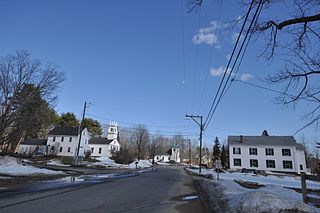
The Deerfield Center Historic District encompasses the heart of the rural New Hampshire town of Deerfield. It extends northwest along Church Street from its junction with North Road, Candia Road, and Raymond Road. It includes many of the town's municipal buildings, as well as a church and private residences, most of which were built before about 1920. The district was listed on the National Register of Historic Places in 2002.

The Woodman Road Historic District of South Hampton, New Hampshire, is a small rural residential historic district consisting of two houses on either side of Woodman Road, a short way north of the state line between New Hampshire and Massachusetts. The Cornwell House, on the west side of the road, is a Greek Revival wood-frame house built c. 1850. Nearly opposite stands the c. 1830 Verge or Woodman House, which is known to have been used as a meeting place for a congregation of Free Will Baptists between 1830 and 1849.

Graham Historic District is a national historic district located at Graham, Alamance County, North Carolina. It encompasses 72 contributing buildings and 1 contributing structure in the central business district of Graham. The district includes a variety of institutional, commercial, and residential buildings largely dating from the 19th century. Notable buildings include the Alamance County Courthouse, the centerpiece of the district; Graham Presbyterian Church; Harden House; Hunter House; Nicks Store; McBride Holt House ; Scott Building ; Vestal Hotel; Holt-Scott General·Store ; National Bank of Alamance ; Mont-White Theatre; and Paris Building.
Terrell Historic District is a national historic district located at Terrell, Catawba County, North Carolina. The district encompasses 11 contributing buildings in the crossroads community of Terrell. Most of the buildings date from the late-19th an early-20th century and includes notable examples of Greek Revival and Late Victorian style architecture. Notable buildings include the Connor Store and Post Office, Coleman-Caldwell-Gabriel House, Sherrill-Gabriel House, Rehobeth Methodist Church, Gabriel Cotton Gin (1932), Cotton Storage Building, and Walter Gabriel House.

The Scott Farm Historic District encompasses a historic farm property at 707 Kipling Road in Dummerston, Vermont. Developed between about 1850 and 1915, Scott Farm is a well-preserved farm and orchard complex of that period. It was listed on the National Register of Historic Places in 2001.

The Waitsfield Village Historic District encompasses much of the main village center of Waitsfield, Vermont. Extending along Vermont Route 100 on either side of Bridge Street, it is a well-preserved example of a 19th-century village, with only a few sympathetic 20th-century additions. It was listed on the National Register of Historic Places in 1983.






















